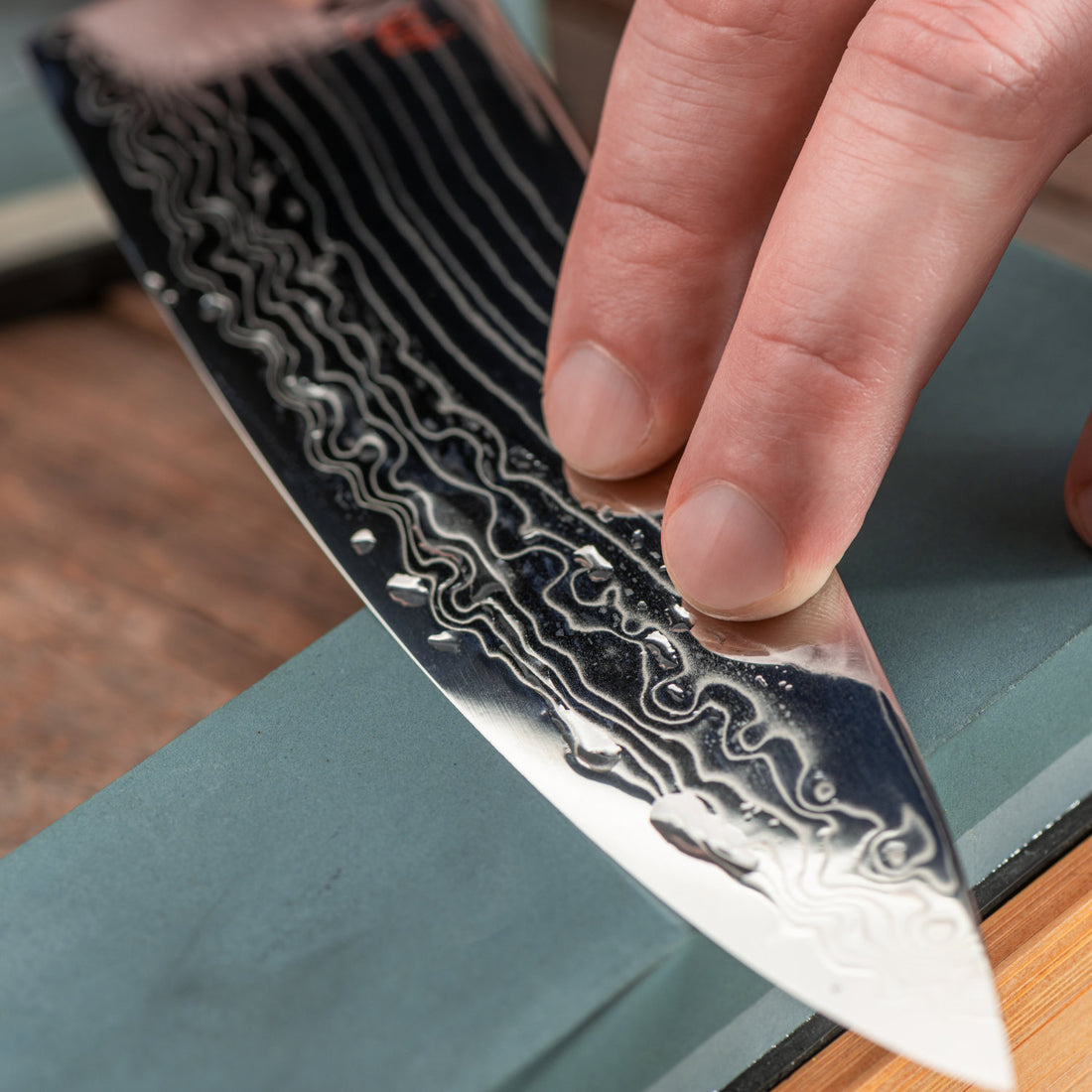How to Sharpen a Kitchen Knife: A Beginner’s Guide

Honing and sharpening your kitchen knives can seem daunting, but it really can be simple with a little instruction. This article will demystify the options and the how-tos of this essential key to proper knife maintenance.
As you know, all knives become dull over time with use, regardless of the knife's quality and whether it's used by a kitchen-novice or a Michelin-star chef.
This guide to knife honing and sharpening provides the step-by-step instructions required to bring your blade back to factory-fresh sharpness using rods, stones or sharpeners. It will also instruct you in the difference between honing and sharpening, as well as when to take each step.
What's the Difference Between Honing and Sharpening a Knife?
As you cut through anything from meat to tomatoes, each time you chop or slice, the microscopic edges of metal on your knife's blade become misaligned. Think of it almost like a fine-toothed comb with the teeth pushed in different directions. Though invisible to the naked eye, this misalignment leads to decreased performance of your knife.
When you hone a knife, you use a honing steel or the honing portion of your sharpener (if applicable) to simply realign these edges. Honing does not take any metal away from the blade, just pushes it back into line.
Best practice is to hone your knives quickly between each use to keep them in peak form. The honing steel that likely came in your knife block is the perfect quick and easy way to accomplish this. It will only take you a few seconds once you get the hang of it, and should become part of your cooking routine.
Sharpening knife blades, on the other hand, removes a small portion of the edge of the original knife blade, and gives the knife a new edge. Sharpening does remove a trace amount of the metal blade itself. If you've ever seen an old knife with a blade that is obviously not in its original shape, it is likely due to sharpening.
As sharpening does take away some of the metal of the original blade, it should be done more sparingly - certainly not as often as honing. Depending on how much you use your knives, they should be sharpened every 6 to 12 months, on average.
How to Hone or Sharpen a Kitchen Knife Using a Honing Steel or a Sharpening Steel

A honing or sharpening rod, also known as a honing or sharpening steel, is the most common knife edge maintenance tool. Not only is a rod easy to use, clean, and store, it comes included with most knife block sets. Knife maintenance rods are relatively inexpensive, and require no upkeep. You can learn how to use these tools below.
The difference between a honing steel and a sharpening steel is the material of the steel itself, and what it does to the blade. Honing steels most often have a surface made of textured steel that will realign the edge of your knife blade.
Sharpening steels often have a coating of microscopic diamonds or ceramic over the stainless steel core, making it a harder surface and allowing the sharpening steel to give your knife's blade a new edge.
Whether you are honing or sharpening your knife with a steel, the process is the same. Below, I will refer to a sharpening steel, but the steps and technique are the same whether you are honing or sharpening.
1. Holding the Sharpening Steel
There are two methods to holding a sharpening steel: vertically or horizontally. Both are equally effective. If you're holding a sharpening steel vertically, which can be easier for beginners, place the end of the sharpening steel onto a cloth on a hard surface, such as a table or countertop. The cloth keeps the steel from slipping as easily. If you are holding it horizontally, hold the sharpening steel in your non-dominant hand, pointing away from yourself and others.
2. Sharpening the Blade
Whether you're holding the steel vertically or horizontally, you'll need to keep the blade at a 20° angle against the rod (or a smaller angle for Asian knives). Many steels have a corner of the handle that is at that exact angle, to help you align the knife blade at the proper angle.
To sharpen the blade, slowly pull the blade along the rod, from the heel of the blade to its tip while simultaneously moving the blade down along the length of the rod. Alternate sides and repeat after finishing each stroke.
A few passes on each side will be enough to hone or sharpen your blade.
3. Cleaning the Blade
It's very important that the knife blade is cleaned after sharpening and before use. There will be small, even microscopic metal particles attached to the blade that the steel has removed. Clean your blade by hand, don't let it soak in any liquids, and dry it immediately to prevent spots and rusting.
If you have honed your blade, a couple of careful swipes with a kitchen towel after honing should be sufficient.
If your knife block did not come equipped with a honing steel, or you need a sharpening steel, shop Swiss Knife Shop's Collection of Steels here.
How to Sharpen a Knife Using a Sharpening Stone

A sharpening stone, or whetstone, is an exceptional and effective method of knife sharpening. To sharpen your blade with a whetstone, you lay your knife blade flat and move it across the stone. Using a sharpening stone, though it can be intimidating at first, is a fairly simple process you will be able to master with a little bit of practice.
Here are a few simple steps that can get you started with sharpening your knives with a whetstone.
1. Lubricating the Stone
Before you start sharpening, you'll need to lubricate the sharpening stone to avoid damaging your knife blade. You can either use oil or water to accomplish this. Your whetstone will come with instructions on the recommended type of lubrication.
2. Sharpening the Blade
Before sharpening your blade with a stone, you'll want to place a damp cloth beneath the stone to keep it in place. As you would with a sharpening steel, hold the knife's blade at a 20° angle to the stone (or smaller with Asian blades). Place the knife's blade on the stone and pull the knife towards you, starting from its heel, up to its tip. Turn the knife over, and repeat this process approximately five to ten times.
3. Cleaning the Blade
As with the sharpening steel, the sharpening stone will create small, loose pieces of metal that have been removed from the blade. Please wash your blade carefully with a damp cloth or in the sink to remove these, and then immediately hand dry your knife to prevent spots and rust.
How to Sharpen a Knife Using a Knife Sharpener

A knife sharpener is the easiest and least intimidating method of knife sharpening. It does not require any preparation, nor does it require that you estimate your knife blade's precise angle.
Knife sharpeners typically include 2 to 4 slots, with options for honing, fine sharpening and coarse sharpening. Some also include slots for blades with different angles - two for European blades that have a 20-degree angle, and two for Asian blades that have smaller angles.
Sharpeners of this type can be manual, meaning you do the work, or electric, where a machine spins sharpening wheels to sharpen the blade.
1. Selecting the Correct Slot
To sharpen a very dull blade, begin with the coarsest setting or slot on your sharpener, then move to the finer slot or slots. This will start with the heavy lifting, and then refine the edge as you progress. Use the coarse slot sparingly, as this will remove the most metal from the knife blade. If your blade is badly nicked or dented, it may be necessary to have your blade professionally sharpened.
2. Sharpening Your Knife
Once you have selected the best coarseness for your blade, simply place the blade's heel (the part of the blade closest to the handle) in the slot and pull the handle toward you along the edge of the blade, exerting just enough pressure on the blade to engage the sharpener. Follow the same process 3 - 4 times on the coarsest setting you are using, down to the finest.



